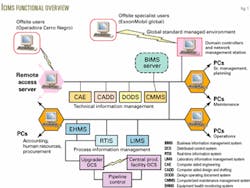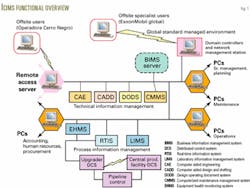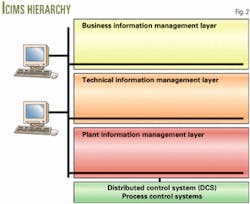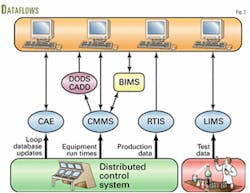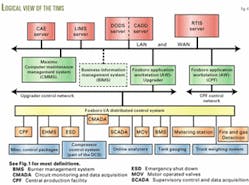Based on a presentation to the National Petrochemical & Refiners Association Computer Conference, Oct. 1-3, 2001, Dallas.
The vertical and horizontal integration of control and information management systems went live in early 2001 at the ExxonMobil Corp.-led joint venture, Operadora Cerro Negro SA (OCN) facilities in Venezuela.
The system, which is called "integrated control and information management systems" (ICIMS), supports cost reduction and performance improvement.
The new ICIMS links operations and control of the heavy crude production facility at Cerro Negro, the upgrader facility at Jose, and the 320-km pipeline that connects the two facilities.
The company has integrated these points across a wide area network with the business information management system (BIMS), based on a common enterprise resource-planning suite installed at the Caracas offices of OCN and ExxonMobil de Venezuela.
The Cerro Negro ICIMS integrates the process control and operations management functions with maintenance management and manufacturing execution systems, including electronic document management and production information management.
Facility-wide networks provide universal access via PCs to all information "from sensors to boardroom."
Business, administrative, operations, and maintenance personnel share a common network and work with the same transaction data and workflow procedures that are built into the ICIMS and BIMS.
ICIMS evolution
The application of integrated control and information management systems in oil and gas production and refining facilities evolved from the need to integrate information across the enterprise.
ICIMS also evolved from the gradual extension of process information flowing from real-time control systems into plant-wide databases for historization and management reporting.
The company's growing realization of the economic and operating benefits of seamlessly linking traditional "islands of automation" drove the integration, which according to some estimates could result in savings of as much as five cents per barrel.
The advent of local-area networks, wide-area networks, and web-based technologies has increasingly enabled information integration and made it accessible from the desktop.
As a result, ICIMS has become a practical and economical option. Moreover, implementing an ICIMS during the engineering, procurement, and construction phase of a project has proven to be more cost-effective than later expansion.
ExxonMobil has led the way in incorporating ICIMS' scope into its grassroots oil and gas projects.
In 1987, Mobil Coryton, concentrated real-time refinery process data in a data collection node, which updated a mainframe database automatically. This made the data immediately available to mainframe resident applications, such as management information and enterprise resource planning systems.
ExxonMobil continued its ICIMS evolution, implementing integrated refinery information systems (IRIS) or process management information systems (PROMIS) at most of the refineries and other major facilities.
It was the success of the ICIMS at ExxonMobil's joint venture LNG plant in Qatar at Ras Laffan(RasGas), however, that most influenced the decision to integrate the systems at OCN.
Ras Laffan ICIMS
ExxonMobil implemented the company's first comprehensive ICIMS in 1999 with the Ras Laffan grassroots LNG facility start up, integrating all control and information systems from sensor to boardroom.
The company's vision was to extend the scope of automation and information management to all activities and job descriptions.
This meant implementing controls horizontally from operation of the offshore platforms to the onshore LNG plant, including onshore and offshore communications.
It also meant implementing controls vertically from the control system through various operating departments, including finance and accounting, human resources, sales and distribution, procurement, and planning. Thus the RasGas ICIMS was born.
The company selected Foxboro, a subsidiary of Invensys PLC, London, and Invensys Process Systems, Foxboro, Mass., as the ICIMS contractor and selected SAP R/3 as the enterprise resource-planning platform.
The plant started ahead of schedule and all systems went live in time for plant commissioning, which enabled early shipments of LNG product, generating greater profit.
In addition to having the infrastructure for cost and performance management in place, the ICIMS provided two additional side benefits. Maintenance data accumulated during the commissioning phase, such as equipment records, were online and available to maintenance managers immediately.
The structuring of business process data for automation facilitated ISO certification significantly, which was another welcome side benefit. ExxonMobil achieved this with a minimum of additional documentation and without the extensive effort to develop procedures, which is normally a major part of the certification process.
Operadora Cerro Negro
Well before the RasGas project was completed, Mobil Oil Corp., now ExxonMobil, entered into the OCN joint venture with Petroleos de Venezuela (PDVSA) and VEBA Oel AG to construct new facilities for producing and processing synthetic crude oil.
The completed project produces extra heavy crude (8° API) at a central production facility (CPF) near Morichal, Venezuela. The facilities dilute the crude oil with naphtha, creating diluted crude oil, which a 320-km pipeline transports to the upgrader at Jose.
The Jose upgrader refines the diluted crude oil, recovering the diluent and producing synthetic crude oil (16° API), with coke and sulfur as byproducts.
Tankers transport the synthetic crude oil to conventional refineries for further processing. A separate diluent pipeline ships the recovered diluent back to the central production facility.
Operating the OCN complex requires:
- Centralized controls at the upgrader and the central processing facility.
- Supervisory control and data acquisition (SCADA) along the pipeline.
- A robust, wide-area communications network.
- Modern enterprise resource planning and information management systems that include automated documentation.
The RasGas project, already under construction, provided ICIMS design concepts and features that ExxonMobil transferred to the Cerro Negro project.
RasGas had already proven that specifying an integrated system up front would save time and money over later modifications and extensions. Operadora Cerro Negro, therefore, adopted the ICIMS approach. Fig. 1 shows a simplified diagram of OCN's ICIMS.
Design strategies
Considering the low oil prices in 1997, Operadora Cerro Negro mandated a fit-for-purpose design, leveraging technology to reduce in-plant operating costs.
Examples include:
- OCN used remote input-output (I/O) to reduce the cost of field cabling while avoiding the expensive, but more common, satellite instrument houses.
- The project used the distributed control system (DCS) for all control applications, avoiding expensive and sometimes unreliable custom-built controls, such as programmable logic controller (PLC)-based controls for packaged units or equipment.
To minimize the cost of anti-surge control equipment, OCN implemented Foxboro compressor control applications, resident in the Foxboro Intelligent Advantage (I/A) DCS, on all centrifugal compressors and blowers.
- The project implemented equipment-health monitoring systems (EHMS) for major pumps and compressors, which were integrated with the communications network for real-time access by authorized specialists in remote skill centers.
- The project integrated voice and data over a wide area network connection, linking the upstream facilities with the pipeline and the upgrader. During construction, the company laid a dual redundant fiber optic link alongside the pipeline.
Fiber optics provided a superior alternative to the terrestrial microwave relay links that are typically used for SCADA communications. These same fiber cables also transport high-speed wide-area network data using modern wavelength division multiplex technology.
- OCN combined the inherent high bandwidth of the fiber-optic link with the advanced features of DCS and SCADA to optimize data integration. This integration, in turn, permits access to process and equipment data across the entire system and provides real-time views from operator consoles both at the upgrader and central production facility.
The upper level client-server applications are then able to span the system. This accessibility facilitates coordination of operations, maintenance, and inventory management among upstream and downstream facilities.
ICIMS architecture
The Cerro Negro ICIMS, being a client-server based information system, provides seamless desktop access to process data, equipment operating data, and enterprise-wide technical and business data.
Fig. 2 shows the hierarchy of control and information systems, while Fig. 3 shows a simplified view of the ICIMS data flow.
Structurally, a secure telecommunication network of local area and wide area networks, connecting technical, plant, and process information systems with the business information management system, define the ICIMS at Operadora Cerro Negro.
A state-of-the-art wide area network, using fiber optic backbones and wavelength division multiplexing with voice and data integration, connects local area networks at the CPF and upgrader with headquarters offices in Caracas.
BIMS layer
The business information management system (BIMS) is a transaction processing system based on JD Edwards enterprise resource planning suite and PSDI Maximo software.
Apart from performing the more conventional data processing functions for finance, human resource, and procurement-inventory management, this system integrates with the technical information systems for seamless data transfer and application sharing.
The procurement and inventory management application, implemented in PSDI Maximo, shares the server with the maintenance management system that is part of the technical information management system.
ICIMS tightly integrates procurement functions with other enterprise resource planning applications.
TIMS layer
Fig. 4 shows the technical information management system (TIMS) layer, consisting of a real-time information management system (RTIS), a computerized maintenance management system (CMMS), a design and operations document system (DODS), and a laboratory information management system (LIMS).
As a client-server system based on OSI Software's PI and PI-ProcessBook suite, the real-time information management system applications include:
- All reporting from plant operations details to management summaries.
- Process engineering graphics and online trending.
- Production scheduling, operator task guides, and operator logs.
- Tank inventory and production monitoring.
- Product specification monitoring.
- Plant and equipment performance monitoring and status reporting.
Foxboro's dynamic maintenance management (FoxDMM) software implements the computerized maintenance management system. FoxDMM, based on the Maximo software package, in turn accesses an Oracle database management system.
Operadora Cerro Negro uses the CMMS to manage equipment maintenance and inventory, which applications include:
- Preventive, predictive maintenance.
- Work order control and inspection management.
- Equipment register.
- Cost management.
- Material control and warehouse management with integral barcode reading, printing systems at the warehouse.
The design and operations document system (DODS) simplifies the procedures for producing, revising, searching, processing, storing, and retrieving engineering and other plant related documents and drawings.
DODS also manages the conventional computer-aided design and drafting (CADD) services, both of which are based on Intergraph AIM-PDME.
DODS supports the storage and management of all designs and operational drawings and documents and is the base for management of change (MOC).
The laboratory information management system (LIMS) aids in collecting and managing laboratory sample and analysis data, both from manual samples and from automated instrumentation.
The network is capable of accepting chromatography readings that have been routed through a PC via an Ethernet connection to the local area network.
Upgrader DCS
The plant information layer integrates the upgrader DCS, the central production facility DCS and SCADA systems, and the SCADA system on the pipeline.
The upgrader DCS system, a Foxboro I/A Version 6.2, controls about 7,000 input-output (I/O) points that are connected to 40 remote I/O enclosures, strategically distributed over the facility.
Hardened and certified for field mounting, the remote I/O cabinets require no air-conditioning or cooling fans.
The remote I/O cabinets connect with the control processors (Foxboro CP 60's) and three operator consoles in the central control building via a star network of fiberoptic "fieldbus" with redundant paths.
A combination of star and mesh topology was used in the fiberoptic "fieldbus" network to optimize security relative to cost, rather than copper signal cabling to DCS equipment in the central control building.
Apart from the above direct connected I/O points, the DCS also collects data from the emergency shutdown, burner management systems, and other "foreign" devices and systems.
Being Triconex (Invensys subsidiary) systems, the emergency shutdown and burner management systems connect directly and seamlessly to the I/A DCS nodes.
Central production facility
The central production facility DCS, similar to the upgrader DCS except smaller in size and scope, connects with 3,500 I/O points.
Only 1,100 connect directly to the DCS at nine remote I/O enclosures. The DCS collects the remaining 2,400 I/O points from 15 custom engineered skids with 2 PLC's each (some variations exist).
This design follows the standard practice in oil field engineering but is a significant departure from the general project philosophy.
Other features include two lease automatic custody transfer (LACT) units, four well test separators, oilfield SCADA, and a vibration monitoring system, all of which connect to the DCS through a fiber optic network with redundant paths.
Pipeline SCADA
The pipeline SCADA system enables control from either the central production facility, or the upgrader, or from both ends with split allocation. Two master stations serve this purpose, with one at the central production facility and the other at the upgrader.
SCADA stations and remote terminal units (CM50CP) control each of the 34 valve stations and pig launching-receiving stations along the 320-km pipeline.
Remote terminal unit shelters also house the necessary communications equipment, such as small PBX's, telephones, data ports, fiber optic patch panels, and regenerators.
The two fiberoptic cables buried next to the pipeline carry all communications, with one for SCADA and one for the wide area network, interchangeably.
The SCADA remote terminal units connect to the master stations through two auto-selected paths. The default path is via a multi-drop, fiberoptic link using Fox-SCADA protocol and the backup path is over a channel in the wide area network.
With the redundancy of the master stations, a break in the fiberoptic link will not disrupt control. The master stations at the central production facility and at the upgrader can control the remote terminal units on each side of the break, via the split allocation.
Implementation
Invensys Process Systems (Foxboro) was selected to be the main automation contractor, under a subcontract to the upgrader engineering, procurement and construction contractor, JGC Corp., Japan.
ICIMS detailed engineering began with a series of design workshops at the JGC's Yokohama office to produce a set of functional requirement specifications for the information management systems and the communications infrastructure and a set of project application specifications for the control systems.
Implementation and testing of each component of the system proceeded along a stringent, phased in schedule between June 1999 and full implementation in January 2001.
Lessons learned
In terms of lessons learned, the authors offer the following advice to others implementing similar projects:
- Do not allow customization (code changes) of application software packages, or forays into unexplored or unproven technological territory.
In the few occasions where customization was permitted, to modify functionality of the JD Edwards One World software, rework and delays affected the BIMS testing schedule.
In addition, product support and ease of version upgrades are complicated when the standard software is altered.
- Treat fiberoptic cable burial over long distances as a long lead item and begin as early as possible. Conduct detailed routing surveys and searches for least-cost routing options before beginning installation.
- Install surge protection on complex electronic devices such as fiberoptic boosters and multi-drop stations in remote sites subject to electric storms, power surges. Implement additional security measures to deter theft in such installations as well.
- Don't cut corners on integration testing. The extensive integrated tests carried out in this project minimized problems usually encountered during commissioning of integrated control systems, local area networks, and TIMS networks and servers.
- Implementing a lump-sum turnkey execution model provides for cost control and built-in protection against scope creep.
- Applying fast-track implementation reduces costs and problems associated with parts management during the construction and commissioning phases.
The initial system design strategies for reducing costs and streamlining installation from the outset proved valid. These include implementing remote I/O, integrating "packaged systems" into the DCS and implementing compressor controls in the DCS.
Designing integrated information systems in from the outset rather than retrofitting them later has proven beneficial.
This has increased availability of maintenance information and eliminated the need for costly, interruptive system changes later on down the road.
Furthermore, the ExxonMobil-led joint venture will enjoy a single point of entry or capture for all enterprise data, which will contribute to operating efficiency and data integrity.
While the company has already commissioned the integrated system, the greatest gains are yet to come as the users are trained and begin to use all facets of the applications.
ExxonMobil's Operadora Cerro Negro upgrader facility, with an open flexible information infrastructure, will support cost savings and performance improvement initiatives for many years to come.
The authors
Nirmal Kumar Dutta consults on ICIMS, infrastructure integration, and related economics. He recently retired from ExxonMobil Corp. where his last assignment was managing the company's ICIMS implementation for the Cerro Negro project. He joined Mobil Oil Corp. in 1979 and was instrumental in pioneering the ICIMS concept during his career. Before joining Mobil Oil, he was with American Hoechst Corp. He holds a masters degree in computer science from the University of Houston.
Don Kendall is director of major projects at Invensys Process Systems, Foxboro, Mass. He has managed or directed more than 20 DCS and main automation contractor projects in the chemical, oil and gas industries. He has more than 30 years' experience in process control and automation, both in project execution and software application development. He holds a BS in chemical engineering from the University of California, Berkeley and an MS in chemical engineering from the University of Southern California.
